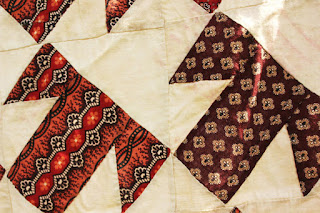Does the T stand for Temperance?
I recently read a paper:
CRUSADING QUILTS: SOCIAL REFORM AND THE WOMAN’S CHRISTIAN TEMPERANCE UNION by Amanda Lensch.
You can find Amanda's graduate paper here for the University of Nebraska.
See particularly pages 18-39 for pattern discussion.
There are many of these T quilts from the end of the 19th century.
I have made assumptions that the T stands for temperance.
I've been intending to do some thorough research in the many 19th-century temperance publications that are now digitized looking for references to symbolism in the pattern. But I don't have to because Amanda has done it well. She doesn't discuss this pattern but looks at others such as Drunkard's Path and Temperance Tree.
And she found nothing to support the ideas of symbolic patterns, particularly in regards to the Women's Christian Temperance Union (WCTU). She writes:
"Questionable Conclusions
Some late 20th century writers assumed that these patterns were used by WCTU members and supporters as a way to indicate their support for the temperance cause. Evidence for this assumption has never been documented.....Research into the origin of the pattern names failed to reveal conclusive evidence that any quilts in these patterns were related to the WCTU."
She didn't find any advice or comments about using specific patterns to support the anti-alcohol cause
in the temperance literature.
But there are other options to pursue. There is the general press---newspapers and magazines for the general reading public, which might have mentioned a link. There are diaries and letters and memoirs.
And then there are all these quilts.
Yet, with all these T quilts I realized I have never seen the kind of link that actually tells us what the T stands for.
The quilts I am posting today feature a sort of a four-patch design,
although the proportions in the four patches aren't equal.
It's BlockBase #1392: all triangles
When I indexed the names I'd found by the early 1970s I had two for this one, both from the same source. Nancy Page, a syndicated newspaper column, called it Double T or Mixed T. Those names certainly have nothing to do with temperance.
Wilene Smith has found earlier published sources and names for her Quilt History Tidbits page.
Wilene's text is in tan above, mine in green. She found the design first as T Pattern from
Farm and Fireside magazine in 1883
and later as
Letter T from
Farm and Home magazine in 1891.
See Wilene's web page on T's here:
But again no idea of what the T represents
Terwilliger,
Taylor,
Todhunter?
Those agricultural magazines with their page for the farm woman
were probably the source of these T quilts.
I found another slight pattern variation, not in BlockBase but
similar to #1392.
It's the same proportions but different pieces. Harder to cut.
This one from Stella Rubin's online shop seems to be from the same
pattern. You can see a closeup here:
When the blocks in either pattern are set all over and shaded right
you get a tessellation. One shape covering the surface with no gaps.
Not one piece---but one shape, the T.
We make a mistake when we try to read symbolism into quilter's past intentions. Without any written links for the T's and temperance all I can say is there are a lot of T quilts out there. And it makes a great T-T-Tessellating pattern.
















I like this blocks a lot! They make such an interesting pattern. Looks awesome!
ReplyDeleteTessellating blocks are so appealing. I'm putting this on my "to do" list. Thanks.
ReplyDeleteDid the Temperance Movement, which by the way preceded the Civil War and lasted to Prohibition, have fund raiser quilts? If so, it would be interesting to see what the patterns were.
ReplyDeleteWhich brings up the question of . . . was there a specific time frame in history when alphabet letters or a block designating a specific letter were used? You've seen the quilts that spelled out, in block form, names and dates I'm sure. Baltimore album quilts were created in a certain area in a certain time period weren't they? I'm wondering if T-quilts and/or alphabet quilts were limited to a certain area and time frame. As always, thanks for sharing Barb.
ReplyDeleteThe designs are great which i thought that it would have a significant meaning or not?
ReplyDeleteBelieve it, Tax Prep
This comment has been removed by the author.
ReplyDeleteI like the second one. The design and colors are great!
ReplyDeleteBelieve it, Sitka Alaska Fishing Charters company
The WCTU is still an active organization. The reason most of the T's for "temperance" are created to look the way they do is they are actually a ribbon. The symbol of the WCTU and the temperance/woman's suffrage movement is a white ribbon. If you look at the "T" it is actually a ribbon. Women in the WCTU wear a white ribbon that looks like that as a pin. The white stands for purity.
ReplyDelete